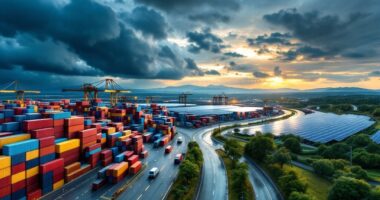Sustainable food systems connect farm production to consumer plates through environmentally sound practices. They reduce greenhouse gas emissions while promoting soil health and biodiversity. Local sourcing creates economic advantages—generating jobs and keeping dollars within communities. Farm-to-table approaches preserve cultural traditions while ensuring fair labor practices for agricultural workers. Despite climate challenges, innovations in urban farming and alternative proteins are shifting the industry toward sustainability. The journey from field to fork reveals responsibility at every step.

Nearly every food choice we make ripples through a complex web of environmental, economic, and social systems. That seemingly innocent apple in your hand? It’s the culmination of countless decisions about soil management, water usage, labor practices, and transportation logistics.
Sustainable food systems aim to orchestrate this complex dance in a way that nourishes both people and planet for generations to come. At its core, a sustainable food system delivers food security while remaining economically viable and environmentally sound.
Think of it as the food world’s equivalent of having your cake and eating it too – except in this case, the cake was grown using regenerative agriculture, processed without excessive waste, and delivered to your table with minimal carbon emissions. These systems prioritize local sourcing and seasonal ingredients – nature’s way of telling us what we should be eating when. The farm-to-table movement embodies this philosophy by directly connecting consumers with local food producers.
Sustainable eating isn’t sacrificing indulgence—it’s feasting on food that nurtures both your body and the earth beneath your feet.
The environmental perks are substantial. When farmers embrace sustainable practices, they’re fundamentally giving the planet a spa day – reduced greenhouse gases, healthier soil, cleaner water, and biodiversity that would make a naturalist swoon. The global food system contributes approximately 26% of emissions to greenhouse gas emissions, making sustainable practices crucial for climate change mitigation.
It’s like hitting the ecological jackpot without buying a ticket. The economic story is equally compelling. Sustainable food systems create jobs faster than a barista makes lattes during morning rush hour.
Farmers often see improved profitability, while local communities benefit from dollars that circulate like neighborhood gossip. Resource efficiency means less money thrown away on inputs that weren’t needed in the first place.
Socially, these systems serve up a hearty portion of benefits – improved food security, better nutrition, and preservation of cultural food traditions that might otherwise disappear faster than cookies at an office party. Soil health is central to sustainable agriculture, ensuring nutrients cycle naturally and reducing dependence on chemical interventions.
Fair labor practices guarantee that the hands that feed us aren’t themselves going hungry. Challenges remain, of course. Balancing the triple bottom line of people, planet, and profit is trickier than a three-armed juggler.
Climate change throws curveballs at farmers daily, and shifting entrenched industrial systems requires persistence. But innovations in technology, urban agriculture, and alternative proteins suggest a future where sustainability isn’t just possible – it’s inevitable.
Frequently Asked Questions
How Does Food Pricing Impact Sustainability Efforts?
Food pricing markedly impacts sustainability efforts through consumer behavior patterns.
Low prices for conventional foods typically mask environmental and social costs, making sustainable options appear expensive by comparison. Research shows consumers are willing to pay only a 9.7% premium for sustainable goods on average.
Economic interventions like true cost accounting, subsidies for sustainable products, and carbon pricing could help align market prices with actual costs, making sustainable choices more accessible while incentivizing responsible production methods.
Can Urban Farming Significantly Reduce Carbon Footprints?
Urban farming presents a mixed environmental picture.
Surprisingly, it produces roughly six times higher carbon emissions per serving than conventional farming (0.42 kg CO2e versus 0.07 kg). Infrastructure accounts for 63% of these emissions.
However, specific urban farming approaches can reduce this gap: extending infrastructure lifetime, using recycled materials, selecting appropriate crops (especially those typically grown in greenhouses), and incorporating urban waste.
Open-air urban tomatoes, for instance, outperform conventional greenhouse-grown varieties in carbon footprint calculations.
What Role Do Food Certifications Play in Transparency?
Food certifications function as credibility shorthand in today’s complex marketplace.
These visible symbols allow consumers to make informed choices without needing to research every product’s background. The certifications effectively bridge information gaps between producers and buyers, with 72% of consumers citing transparency as extremely important.
Beyond marketing advantages, they establish accountability standards that benefit the entire supply chain. For many shoppers, these labels serve as trusted guides through an otherwise overwhelming sea of product claims.
How Do Consumer Habits Affect Sustainable Food Systems?
Consumer habits greatly impact sustainable food systems through four key channels.
Purchasing choices directly influence production methods, with affordability being the primary barrier to sustainable options.
The convenience factor shapes consumption patterns, as 41% of consumers want easy access to sustainable products.
Health perceptions drive decisions, with 55% prioritizing nutrition alongside sustainability.
Finally, awareness gaps hinder progress—despite 65% wanting to make sustainable choices, many lack knowledge about environmental impacts of their food selections.
Can Technology Solve Distribution Challenges in Food Deserts?
Technology offers promising solutions for food deserts, though not a silver bullet. Mobile grocery stores, vertical farming, and AI-optimized distribution systems can bring nutritious food to underserved areas.
However, these solutions face significant hurdles: limited internet access, transportation barriers, higher operational costs, and workforce challenges.
Most effective approaches combine tech innovations with policy initiatives—like tax incentives for grocers and expanded public transit—creating multilayered solutions that address both immediate access needs and underlying systemic issues.









